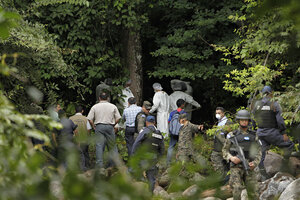Miss Honduras's killing all too familiar in world's murder capital
The beauty queen's murder by her sister's boyfriend is just a high-profile example of the sort of violence – particularly against women – that has given Honduras the worst per capita murder rate outside a war zone.

Police and forensic workers inspect the site where the bodies of Miss Honduras 2014 and her sister were found in the village of Cablotales, near Santa Barbara, Honduras, Wednesday.
AP
The murder of a Honduran beauty queen and her sister has drawn attention not only to their Central American nation’s high murder rate, but the scourge of violence against women there.
The bodies of Maria Jose Alvarado and her older sister Sofia were found buried near a river about 240 miles west of Tegucigalpa, the capital, a week after they’d gone missing. They were found just hours before Ms. Alvarado was to fly to London to represent Honduras in the Miss World pageant.
The sister's boyfriend, Plutarco Ruiz, led investigators to the gravesite this week. Mr. Ruiz allegedly shot the young women at his birthday party in "a fit of jealousy" after Sofia danced with another man, Reuters reports. Alvarado was shot twice in the back.
Much as the murder of a former beauty queen in Venezuela in January shone a spotlight on that nation’s high crime and murder rates, the killing of the Alvardo sisters has brought international scrutiny of a problem all too familiar to many in Honduras. Honduras has the highest murder rate in the world outside of a war zone, with 82.1 homicides per 100,000, according to the most recent United Nations data. On top of that, only an estimated 5 percent of murders are solved.
According to The Center for Women’s Rights in Tegucigalpa, 328 women have been killed in Honduras so far this year.
"The case of Mary Jose and Sofia show clearly the situation of generalized violence against women and the nonexistent response of the Honduran government to prevent, investigate or punish it," the center wrote in a statement.
Poorly trained police and underfunded prosecutors are often unwilling or unable to investigate homicides, reports The New York Times. Furthermore, there's no system in place to track missing people, reports Salvadoran news outlet El Faro. In this case, however, military police were sent on a high-profile search for the missing women.
“Many girls die this way but because they aren’t famous, nobody pays attention,” Salvador Nasrallah, a TV host and former presidential candidate, told The New York Times.
According to a 2012 story by The Christian Science Monitor, Latin America has seen a spike in reports of violence against women in recent years.
"Femicides in Mexico, Guatemala, Honduras, and El Salvador have all shot up in recent years, registering some of the highest rates in the world. The latter has seen the biggest spike in femicide in Latin America, with 637 women murdered in 2011, almost quadruple the rate from a decade ago, says Silvia Juarez, who heads the violence against women program for the Organization of Salvadoran Women for Peace," the Monitor reports.
…violence against women in Latin America [is] a worrying trend in a region that has seen enormous advances for women over the past decade. Forty percent of the region is now led by women: [In 2012, there were] female heads of state in Brazil, Argentina, Costa Rica, Trinidad and Tobago, and Jamaica. Women have reached equal access to education and have increasingly joined the workforce. Awareness has also grown around the issues of violence against women through a spate of legislation aimed at protecting them.
But this progress stands in sharp contrast to gender-based violence that has long plagued the region, and is now manifesting itself in new and dangerous ways.
In some countries violence against women is far worse today, from a spike in femicides – the gender-based killing of women – in places like El Salvador and Honduras, where the drug war has become deadlier, to the disturbing trend of acid attacks against women in Colombia….
[In April 2012] Nadine Gasman, the head of UNiTE to End Violence against Women for Latin America and the Caribbean, a UN initiative that fights impunity and works to change cultural attitudes, attended a meeting with police, prosecutors, and justice ministries across the region to talk about violence against women.
"What was clear is that there is an increased number of [acts of] exacerbated cruelty," Ms. Gasman says. "We don't understand why."
Violence against women is linked to a number of factors, including hard economic times and communities where violent crime is endemic. But Gasman, like many observers, says that part of the spike in several countries could be attributed to different paces of change in society: Women are reporting crime more, but justice systems are not responding, making them even more vulnerable.…
"We had her gown ready and her traditional dress costumes," Mr. Nasrallah, who employed Alvarado as a model on his TV game show, told The Associated Press.
He added, "This is not a crime of passion; this is machismo."

